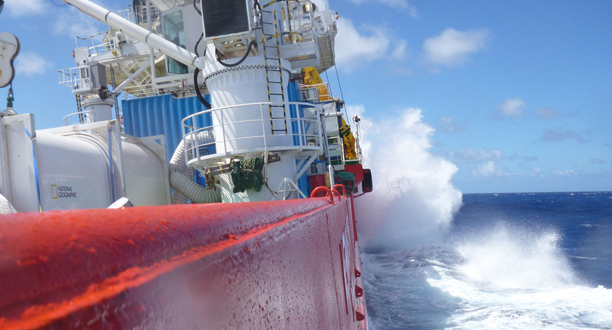A Force 6 Sea

In the western Pacific, south of Guam
The big waves and swells predicted in yesterday’s forecast have arrived. The best place to see their sobering size and movement is through a porthole—a round opening in the hull just above the waterline—in the ship’s mess hall. Rows of white-foam crests reach out to the horizon. Blue-backed swells march along beneath them. As the ship drives forward at ten knots, flecks of foam fly across the nearby water. Sometimes the ship dives into a swell and the porthole is completely submerged. For a few seconds you see what the sub pilot sees when the DEEPSEA CHALLENGER slips beneath the ocean: swirls of sunlight and water. Occasionally, when the ship slams into a really big swell, there is the muted sound of a car crash.
We’re 150 miles (241 kilometers) south of Guam and making our way north through what mariners call a Force 6 sea. Winds are in excess of 25 knots. Swells are as high as 13 feet (4 meters). Now and then the ocean and the bow collide at just the right angle and white spray arcs up against the superstructure. After an hour of this, the dried salt on the bridge windows is thick enough to blur your vision.
The winds picked up last night as we steamed north under a cloudless sky. Venus and Jupiter appeared within a few degrees of each other high in the west. The Southern Cross was planted firmly over our starboard quarter. Throughout the long night, the ship was so active that no one except a few old sea dogs got much sleep. Some of us jammed our backs against the wall and our feet against the berth boards and closed our eyes. Others stuffed life jackets under one side of the mattress and kept their eyes open.
For the second day in a row, the mess hall is empty at breakfast. Serious seasickness has taken five men down. Their faces are ashen. They move with geriatric gaits and speak in grunts. All of them have retained their sense of humor. “I’m not sure I’m cut out for this kind of torture,” one of them tells me with a grin.
In this kind of weather, you don’t go out on deck alone. If you slip, lose your grip, and fall overboard hours will pass before anyone notices the quaint fact that you’re missing. By the time the ship turns around and steams back to find you—likely in the middle of the night—your long monologue with the wind and the waves and the sharks will be over.
According to the charts, the Challenger Deep is 100 miles (161 kilometers) west of the ship’s course. At the moment, sea conditions over the world’s deepest trench are similar to ours.
Photograph by Joe MacInnis



